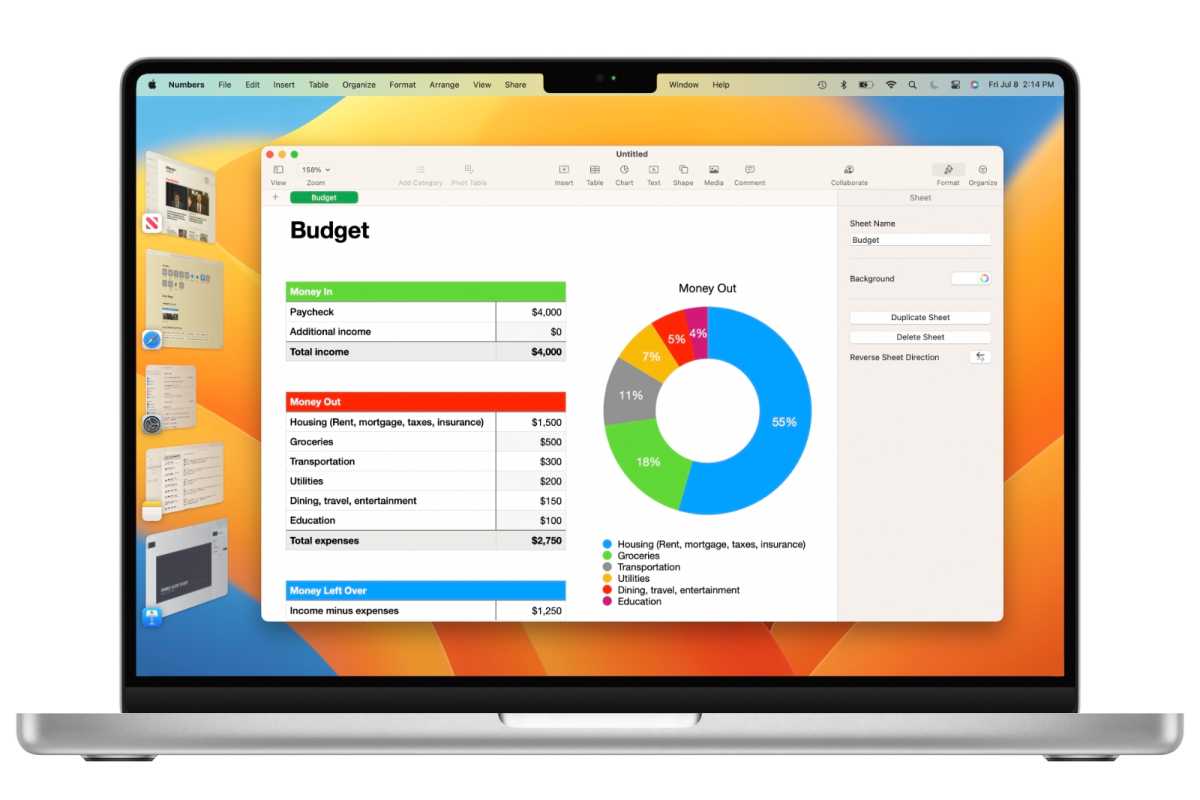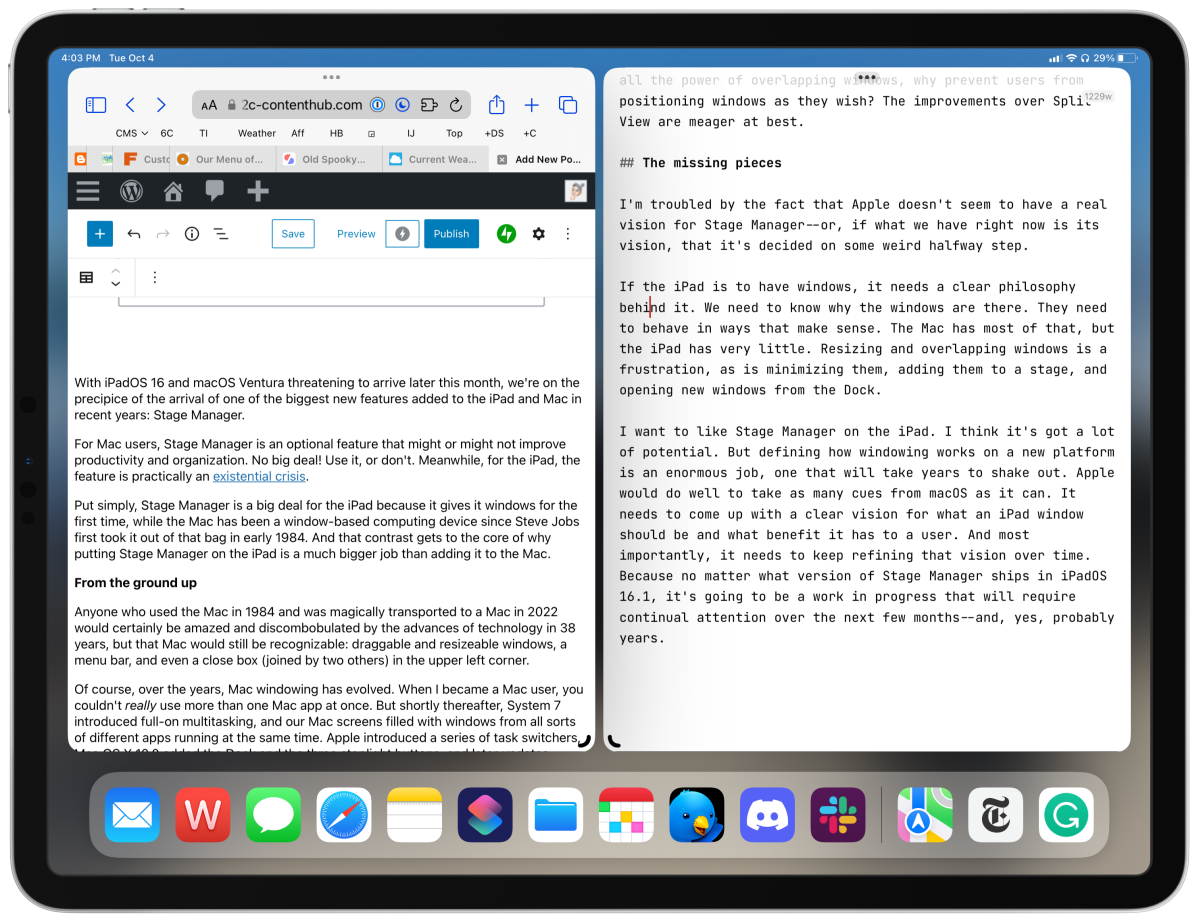
Stage Manager is a window into the future of the iPad—a broken one
With iPadOS 16 and macOS Ventura threatening to get there afterwards this month, we’re on the precipice of the arrival of a person of the biggest new features included to the iPad and Mac in recent many years: Stage Manager.
For Mac users, Phase Supervisor is an optional characteristic that could possibly or may well not increase productiveness and group. No large offer! Use it, or never. Meanwhile, for the iPad, the aspect is nearly an existential disaster.
Place just, Phase Supervisor is a large deal for the iPad mainly because it gives it home windows for the 1st time, when the Mac has been a window-dependent computing machine considering that Steve Jobs initially took it out of that bag in early 1984. And that distinction receives to the core of why placing Phase Supervisor on the iPad is a much more substantial job than incorporating it to the Mac.
From the ground up
Everyone who applied the Mac in 1984 and was magically transported to a Mac in 2022 would definitely be surprised and discombobulated by the developments of technologies in 38 years, but that Mac would still be recognizable: draggable and resizeable home windows, a menu bar, and even a near box (joined by two other folks) in the upper still left corner.

Foundry
Of study course, above the decades, Mac windowing has advanced. When I grew to become a Mac person, you could not really use a lot more than one particular Mac app at once. But shortly thereafter, Program 7 released comprehensive-on multitasking, and our Mac screens filled with windows from all kinds of distinct apps managing at the exact time. Apple introduced a sequence of activity switchers, Mac OS X 10. extra the Dock and the three stoplight buttons, and later on updates extra the capacity to control windows with Exposé, Spaces, and Mission Control.
In other phrases, Apple took a concept–the unique Mac interface–and then iterated on it for 38 a long time. It is not perfect–most notably, the organization has expended a pair of a long time striving to figure out methods for standard end users to find home windows that have been misplaced at the rear of other windows–but it’s received a authentic infrastructure powering it. It’s a metaphor that has been extended and elaborated upon with iconography, menu bar instructions, keyboard shortcuts, trackpad gestures–the is effective.
The iPad’s been about for a lot more than a 10 years, but its heritage with windowing is in essence nonexistent. iPadOS 15 released Fast Observe and the “floating centre window” in applications like Mail–they were home windows, sort of, but one particular-off home windows that adopted their individual guidelines. However, it was a tentative commence. But over and above that, there is seriously absolutely nothing to outline what a window on an iPad could be, how it ought to behave, and how a user would deal with a bunch of them.
So macOS Ventura will carry Stage Manager to the Mac, exactly where it will be shuffling and handling acquainted windows in new techniques. Which is not nothing, but it can acquire gain of 38 a long time of infrastructure and interface grammar.
On the iPad, while, Stage Supervisor must virtually produce an totally new windowing metaphor, out of complete fabric, on working day just one. It’s an enormous work. Is it any ponder that all summer months, Apple has seemingly struggled with it?
An iPad id disaster
Let’s get the job done backward for a instant: What difficulty on the iPad is Stage Manager meant to resolve? It’s supposedly the incapability for end users to swiftly perform with several home windows and multiple applications, as they do on the Mac. The larger sized your display–and my iPad Pro’s screen is only slighter than my MacBook Air’s–the additional space you have for much more windows, and the much more absurd the iPad’s one particular- or two-apps-at-a-time interface gets to be.
The difficulty with the recent approach to iPad multitasking, Break up Watch, is that it commences to split down when you want to use extra than two “windows” (they are truly tiles) at the moment. Even though tiled interfaces are extremely area efficient–there’s no will need for window chrome!–they’re also pretty inflexible. I attempt to think about making a four-paned perspective on my iPad Pro, and I image a frustrating puzzle. I know that tiling has its adherents, but I am not one of them.
Home windows, on the other hand, are time-examined and have a ton of rewards. While they do call for a lot of window chrome that can take up area, they have the benefit of overlapping with a single yet another. Longtime Mac consumers could possibly not even see that they’re accomplishing it, but the natural beauty of overlapping home windows is that you can have various documents at the ready though a single unique doc is front and heart. It’s an effective use of space simply because it doesn’t need the contents of each and every open up window to be on display at once.

Jason Snell
The problem with iPadOS 16’s Stage Supervisor is that it just can’t determine what it needs to be. It gives home windows, so you’d think that it would have made the decision to lean toward the Mac design and style of carrying out matters. But a single of the best characteristics of home windows is that they can be arbitrarily resized and moved around–a attribute that Stage Supervisor resists. iPad home windows can only be opened to certain measurements and shapes, and most frustratingly, they can only be dragged into specific locations.
When I try to use Stage Supervisor on my iPad Pro, I nearly close up with a solitary configuration: two home windows, a lot more or much less equally sized, following to each individual other. I conclude up so frustrated with Stage Supervisor that I essentially re-create Break up Look at! (In actuality, if you position two windows in this way and turn off Stage Manager, it literally transforms into a Split Look at.)
I simply cannot speak to why Apple chose this hybrid tactic, but I cannot say that it makes sense to me. If the target is to provide all the electrical power of overlapping windows, why protect against people from positioning home windows as they desire? Consequently the enhancements above Split See are meager at best.
The missing items
I’m troubled by the simple fact that Apple does not seem to be to have a serious eyesight for Phase Manager–or, if what we have proper now is its vision, that it’s determined on some bizarre midway step.
If the iPad is to have windows, it requirements a clear philosophy powering it. We require to know why the windows are there. They require to behave in methods that make feeling. The Mac has most of that, but the iPad has incredibly tiny. Resizing and overlapping home windows is a irritation, as is minimizing them, introducing them to a stage, and opening new home windows from the Dock.
I want to like Phase Manager on the iPad. I think it’s bought a great deal of probable. But defining how windowing will work on a new system is an massive position, a single that will consider a long time to shake out. Apple would do perfectly to acquire as several cues from macOS as it can. It demands to come up with a distinct eyesight for what an iPad window should really be and what gain it has to a person. And most importantly, it needs to maintain refining that eyesight about time. Since no subject what variation of Stage Manager ships in iPadOS 16.1, it is going to be a operate in development that will demand continual consideration over the future couple of months–and, of course, most likely decades.
